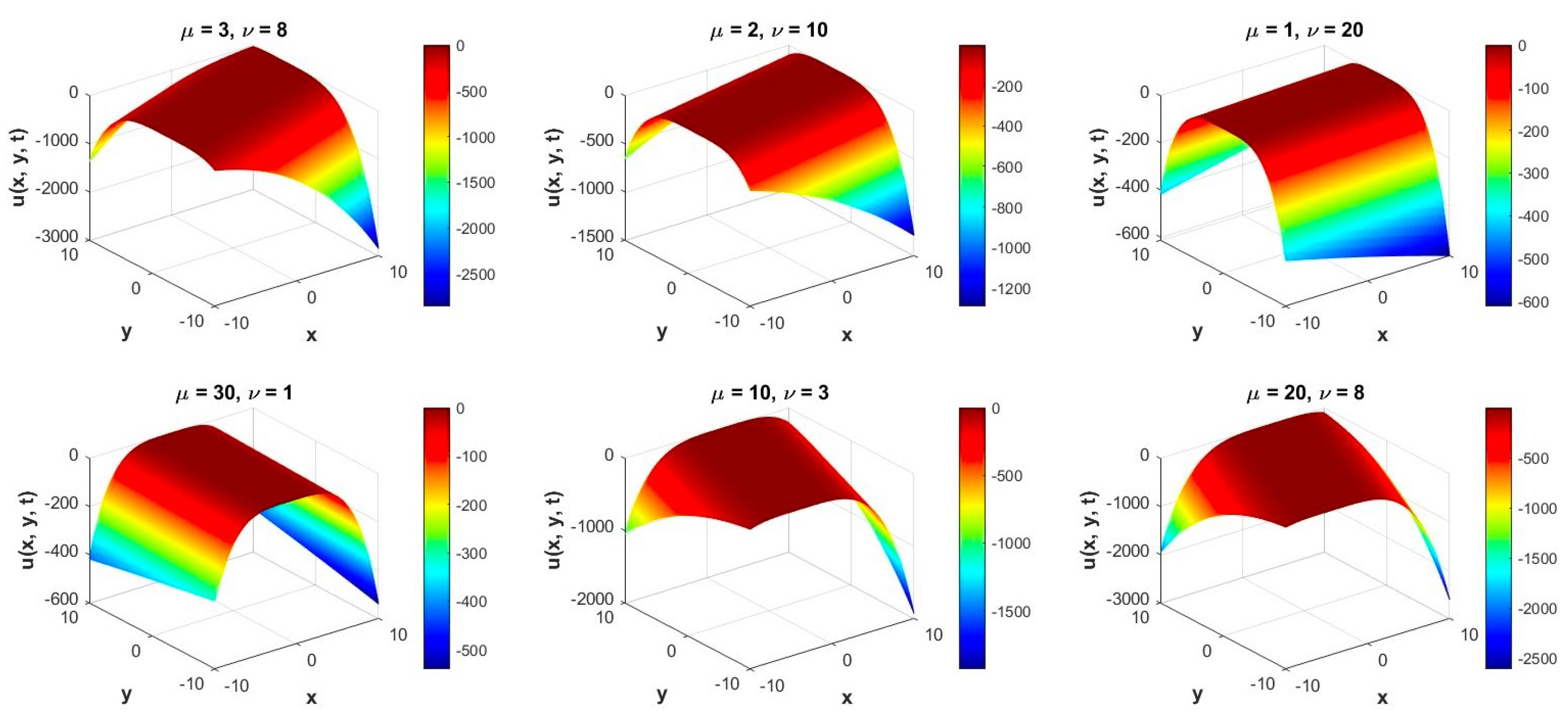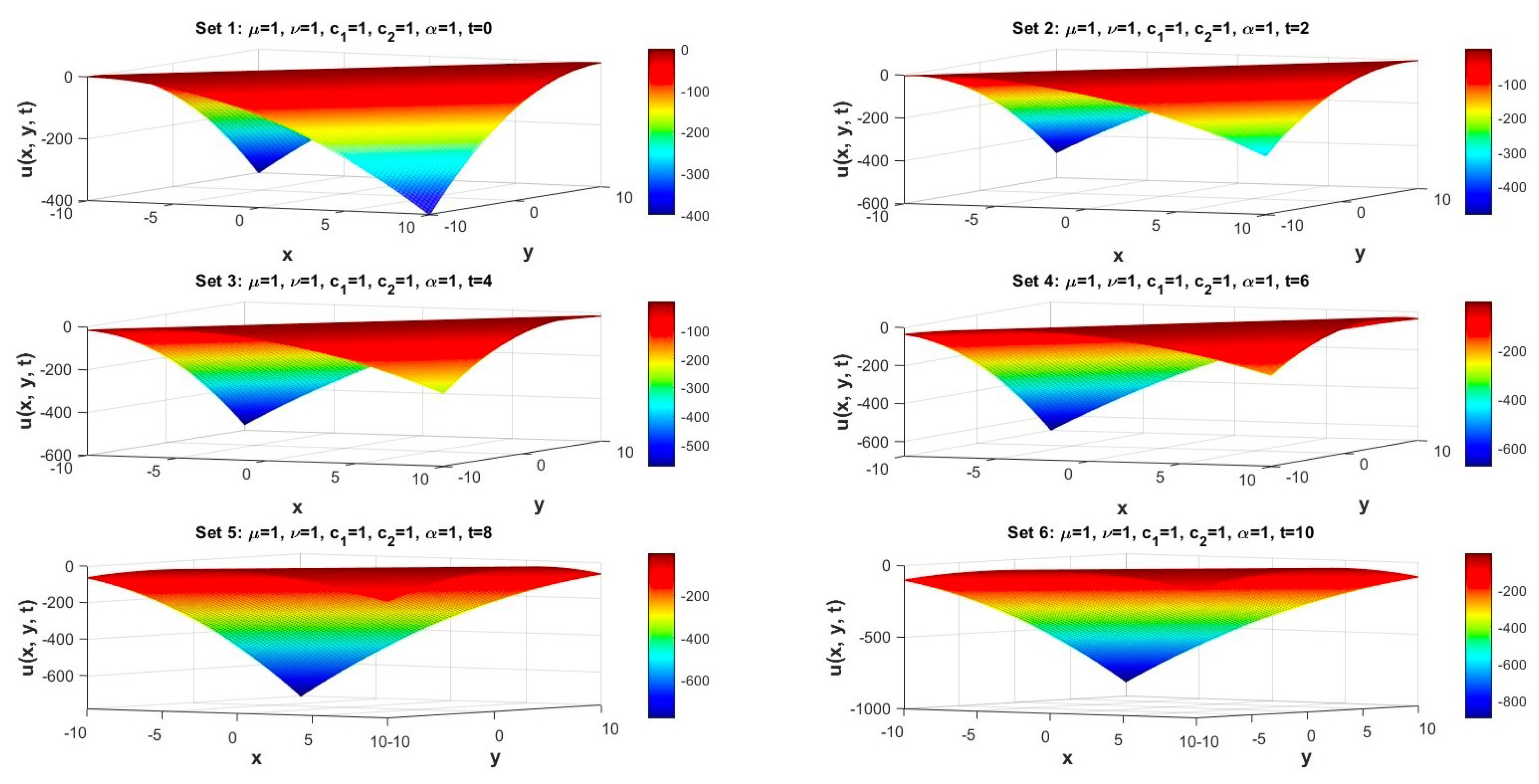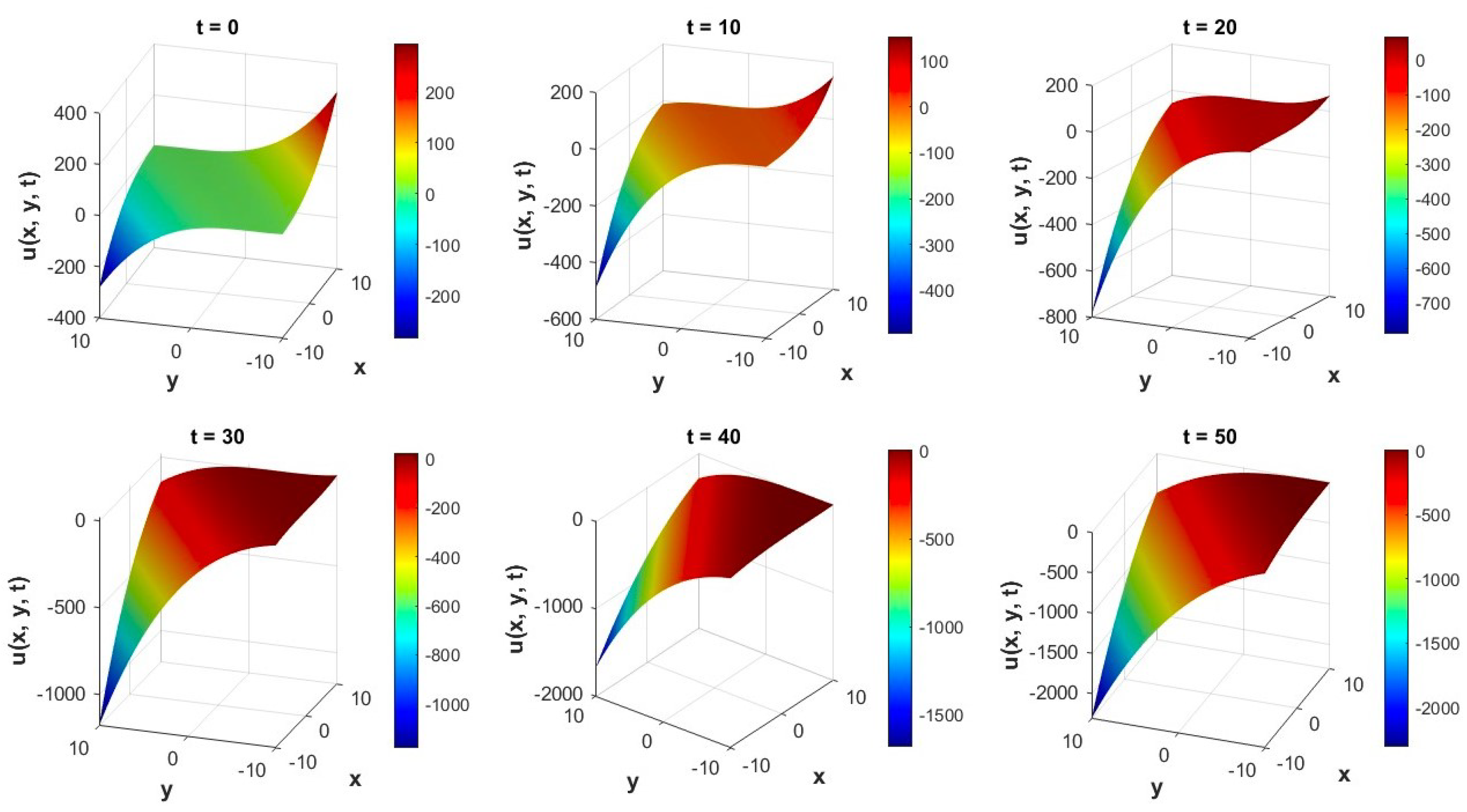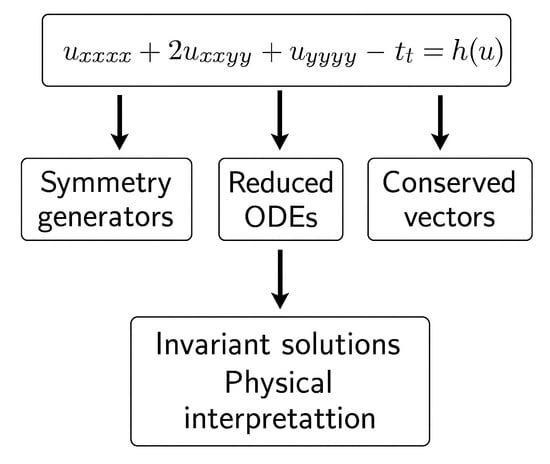Variational Analysis and Integration of the (2 + 1) Fourth-Order Time-Dependent Biharmonic Equation via Energy and Momentum Conservation
Abstract
1. Introduction
2. Determining Equations
2.1. Symmetry Classification
| 0 | 0 | 0 | ||
| 0 | 0 | 0 | ||
| 0 | 0 | 0 | 0 | |
| 0 | 0 |
| 0 | 0 | 0 | 0 | |||
| 0 | 0 | 0 | 0 | |||
| 0 | 0 | 0 | 0 | 0 | ||
| 0 | 0 | 0 | 0 | |||
| 0 | 0 | 0 | ||||
| 0 | 0 | 0 | 0 | 0 | 0 |
| 0 | 0 | 0 | 0 | ||
| 0 | 0 | 0 | 0 | ||
| 0 | 0 | 0 | 0 | 0 | |
| 0 | 0 | 0 | |||
| 0 | 0 | 0 | 0 | 0 |
| 0 | 0 | 0 | |||
| 0 | 0 | 0 | |||
| 0 | 0 | 0 | 0 | ||
| 0 | 0 | ||||
| 0 |
2.2. Noether Symmetries
3. Conservation Laws
Arbitrary
4. Reductions
5. Analysis of Reduced ODE
5.1. Analysis of Reduced ODE for Case I, When
5.2. Analysis of Reduced ODE for Case II, When
5.2.1. Reduction Under
5.2.2. Reduction Under
5.3. Solution of the Form for ODE (50)
6. Conclusions
Author Contributions
Funding
Data Availability Statement
Conflicts of Interest
References
- Bause, M.; Lymbery, M.; Osthues, K. C1-conforming variational discretization of the biharmonic wave equation. Comput. Math. Appl. 2022, 119, 208–219. [Google Scholar] [CrossRef]
- Das, A.; Lamichhane, B.P.; Nataraj, N. A unified mixed finite element method for fourth-order time-dependent problems using biorthogonal systems. Comput. Math. Appl. 2024, 165, 52–69. [Google Scholar] [CrossRef]
- Li, M.; Nikan, O.; Qiu, W.; Xu, D. An efficient localized meshless collocation method for the two-dimensional Burgers-type equation arising in fluid turbulent flows. Eng. Anal. Bound. Elem. 2022, 144, 44–54. [Google Scholar] [CrossRef]
- Bluman, G.W.; Anco, S.C. Symmetry and Integration Methods for Differential Equations; Springer: Berlin/Heidelberg, Germany, 2000. [Google Scholar]
- Masood, Y.; Kara, A.H.; Zaman, F.D. An invariance and closed form analysis of the nonlinear biharmonic beam equation. Malays. J. Math. Sci. 2023, 17, 211–225. [Google Scholar] [CrossRef]
- Bokhari, A.H.; Mahomed, F.M.; Zaman, F.D. Symmetries and integrability of fourth-order Euler-Bernoulli Beam equation. J. Math. Phys. 2010, 51, 053517. [Google Scholar] [CrossRef]
- Anco, S.C.; Bluman, G.W. Direct construction method for conservation laws of partial differential equations Part1: Examples of conservation law classifications. Eur. J. Appl. Math. 2002, 13, 545–566. [Google Scholar] [CrossRef]
- Anco, S.C.; Bluman, G. Direct construction method for conservation laws of partial differential equations Part2: General treatment. Eur. J. Appl. Math. 2002, 13, 567–585. [Google Scholar] [CrossRef]
- Ibragimov, N.H. Transformation Groups AppLied to Mathematical Physics; Springer: Berlin/Heidelberg, Germany, 1983. [Google Scholar]
- Ibragimov, N.H. Elementary Lie Group Analysis and Ordinary Differential Equation; John Wiley and Sons: Hoboken, NJ, USA, 1999. [Google Scholar]
- Ibragimov, N.H.; Kolsrud, T. Lagrangian approach to evolution equations: Symmetries and conservation laws. Nonlinear Dyn. 2004, 36, 29–40. [Google Scholar] [CrossRef]
- Ovsiannikov, L.V. Group Analysis of Differential Equations; Academic Press: New York, NY, USA, 1982. [Google Scholar]
- Kara, A.H.; Mahomed, F.M. Relationship between symmetries and conservation laws. Int. J. Theor. Phys. 2000, 39, 23–40. [Google Scholar] [CrossRef]
- Olver, P.J. Applications of Lie Groups to Differential Equations; Springer: New York, NY, USA, 1993. [Google Scholar]
- Love, A.E.H. A Treatise on the Mathematical Theory of Elasticity; Cambridge University Press: Cambridge, UK, 1927. [Google Scholar]
- Timoshenko, S.; Woinowsky-Krieger, S. Theory of Plates and Shells; McGraw-Hill: New York, NY, USA, 1959. [Google Scholar]
- Pucci, P.; Serrin, J. The Maximum Principle for Nonlinear Elliptic Equations. J. Differ. Equ. 1986, 64, 221–259. [Google Scholar]
- Mitidieri, E. A Rellich type identity and applications. Commun. Partial. Differ. Equ. 1993, 18, 125–151. [Google Scholar] [CrossRef]
- Gazzola, F.; Grunau, H.-C.; Sweers, G. Polyharmonic Boundary Value Problems; Springer: Berlin/Heidelberg, Germany, 2010. [Google Scholar]
- Biler, P.; Hebisch, W.; Nadzieja, T. The Debye system: Existence and large time behavior of solutions. Nonlinear Anal. 1995, 23, 1189–1209. [Google Scholar] [CrossRef]
- Boyd, J.P. Weakly Nonlocal Solitary Waves and Beyond-All-Orders Asymptotics; Kluwer Academic Publishers: New York, NY, USA, 1998. [Google Scholar]
- Wang, S. Symmetry analysis and exact solutions for nonlinear higher-order wave equations. Appl. Math. Lett. 2006, 19, 758–764. [Google Scholar] [CrossRef]
- Anco, S.C.; Gandarias, M. Symmetry multi-reduction method for partial differential equations with conservation laws. Commun. Nonlinear Sci. Numer. Simul. 2020, 91, 105349. [Google Scholar] [CrossRef]




| Case | Symmetry/Ansatz | Solution Form | Type | |
|---|---|---|---|---|
| I | Quartic traveling wave | |||
| II | Symmetry reduction | (58) | Modulated wave | |
| III | Cubic traveling wave |
Disclaimer/Publisher’s Note: The statements, opinions and data contained in all publications are solely those of the individual author(s) and contributor(s) and not of MDPI and/or the editor(s). MDPI and/or the editor(s) disclaim responsibility for any injury to people or property resulting from any ideas, methods, instructions or products referred to in the content. |
© 2025 by the authors. Licensee MDPI, Basel, Switzerland. This article is an open access article distributed under the terms and conditions of the Creative Commons Attribution (CC BY) license (https://creativecommons.org/licenses/by/4.0/).
Share and Cite
Masood, Y.; Kara, A.H.; Zaman, F.D.; Raza, A. Variational Analysis and Integration of the (2 + 1) Fourth-Order Time-Dependent Biharmonic Equation via Energy and Momentum Conservation. Symmetry 2025, 17, 1845. https://doi.org/10.3390/sym17111845
Masood Y, Kara AH, Zaman FD, Raza A. Variational Analysis and Integration of the (2 + 1) Fourth-Order Time-Dependent Biharmonic Equation via Energy and Momentum Conservation. Symmetry. 2025; 17(11):1845. https://doi.org/10.3390/sym17111845
Chicago/Turabian StyleMasood, Yasir, A. H. Kara, F. D. Zaman, and Ali Raza. 2025. "Variational Analysis and Integration of the (2 + 1) Fourth-Order Time-Dependent Biharmonic Equation via Energy and Momentum Conservation" Symmetry 17, no. 11: 1845. https://doi.org/10.3390/sym17111845
APA StyleMasood, Y., Kara, A. H., Zaman, F. D., & Raza, A. (2025). Variational Analysis and Integration of the (2 + 1) Fourth-Order Time-Dependent Biharmonic Equation via Energy and Momentum Conservation. Symmetry, 17(11), 1845. https://doi.org/10.3390/sym17111845










